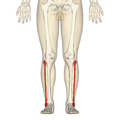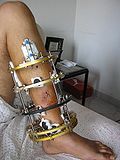Ilizarov apparatus: Difference between revisions
mNo edit summary |
CSV import |
||
| (One intermediate revision by the same user not shown) | |||
| Line 1: | Line 1: | ||
= Ilizarov | {{Infobox medical device | ||
| name = Ilizarov apparatus | |||
| image = Ilizarov on right leg.jpg | |||
| caption = Ilizarov apparatus applied to a patient's right leg | |||
| invented = 1950s | |||
| inventor = [[Gavriil Ilizarov]] | |||
| purpose = Bone lengthening, fracture treatment, deformity correction | |||
}} | |||
The '''Ilizarov apparatus''' is an external fixator used in orthopedic surgery to lengthen or reshape limb bones, treat complex and/or open bone fractures, and in cases of infected non-unions of bones that are not amenable to other techniques. It was invented by the Soviet orthopedic surgeon [[Gavriil Ilizarov]] in the 1950s. | |||
The | ==History== | ||
The Ilizarov apparatus was developed by Gavriil Ilizarov, a Soviet physician, in the 1950s. Initially, it was used in the Soviet Union for treating soldiers with complex fractures and deformities. The device gained international recognition in the 1980s when it was introduced to the Western world. Its ability to treat difficult cases of bone fractures and deformities made it a revolutionary tool in orthopedic surgery. | |||
== | ==Design and Function== | ||
The Ilizarov apparatus consists of a series of rings and rods that are attached to the bone through the skin using wires and pins. The rings are connected by adjustable rods, which allow for precise control of the bone segments. This design enables the apparatus to apply tension to the bone, promoting new bone growth through a process known as distraction osteogenesis. | |||
===Components=== | |||
* '''Rings''': Circular metal frames that encircle the limb. | |||
* '''Rods''': Adjustable metal rods that connect the rings and allow for movement and adjustment. | |||
* '''Wires and Pins''': Thin metal wires and thicker pins that are inserted through the skin and into the bone to hold the apparatus in place. | |||
== | ==Applications== | ||
The Ilizarov apparatus | The Ilizarov apparatus is used in various orthopedic procedures, including: | ||
* '''Limb Lengthening''': Gradually lengthening bones to correct discrepancies in limb length. | |||
* '''Fracture Treatment''': Stabilizing complex fractures, especially those that are open or have not healed properly. | |||
* Lengthening | * '''Deformity Correction''': Correcting angular deformities of the bones. | ||
* '''Non-union Treatment''': Promoting healing in bones that have failed to unite after a fracture. | |||
* Treatment | |||
* Correction of | |||
== Procedure == | ==Procedure== | ||
The application of the Ilizarov apparatus is a surgical procedure that involves: | |||
1. '''Insertion of Wires and Pins''': The surgeon inserts wires and pins through the skin and into the bone. | |||
2. '''Attachment of Rings''': The rings are attached to the wires and pins, encircling the limb. | |||
3. '''Adjustment of Rods''': The rods are adjusted to apply tension to the bone, promoting new bone growth. | |||
4. '''Post-operative Care''': Regular adjustments and monitoring are required to ensure proper bone growth and alignment. | |||
== | ==Advantages and Disadvantages== | ||
== | ===Advantages=== | ||
* | * Allows for gradual correction of deformities and length discrepancies. | ||
* [ | * Can be used in cases where internal fixation is not possible. | ||
* Promotes natural bone healing through distraction osteogenesis. | |||
===Disadvantages=== | |||
* Requires a long treatment period, often several months. | |||
* Can be uncomfortable for the patient. | |||
* Risk of infection at the pin sites. | |||
==Notable Cases== | |||
[[Valeriy Brumel]], a Soviet high jumper, used the Ilizarov apparatus to recover from a severe leg injury, allowing him to return to competition. | |||
==Also see== | |||
* [[Distraction osteogenesis]] | |||
* [[Orthopedic surgery]] | |||
* [[Bone fracture]] | |||
* [[External fixation]] | |||
==References== | |||
* Ilizarov, G. A. (1992). "The Tension-Stress Effect on the Genesis and Growth of Tissues: Part I. The Influence of Stability of Fixation and Soft-Tissue Preservation." Clinical Orthopaedics and Related Research. | |||
* Paley, D. (1990). "Problems, obstacles, and complications of limb lengthening by the Ilizarov technique." Clinical Orthopaedics and Related Research. | |||
{{Medical devices}} | |||
{{Orthopedic surgery}} | |||
[[Category:Orthopedic surgical procedures]] | [[Category:Orthopedic surgical procedures]] | ||
[[Category:Medical devices]] | [[Category:Medical devices]] | ||
<gallery> | |||
File:Ilizarov on right leg.jpg|Ilizarov apparatus on right leg | |||
File:Shaft-bow-1.jpg|Shaft-bow | |||
File:Valeriy Brumel 1968.jpg|Valeriy Brumel 1968 | |||
File:Tibia - frontal view.png|Tibia - frontal view | |||
File:Fibula - anterior view.png|Fibula - anterior view | |||
File:Ilizarov6.jpg|Ilizarov apparatus | |||
File:Ilizarov5.jpg|Ilizarov apparatus | |||
File:Ilizarov4.jpg|Ilizarov apparatus | |||
File:Ilizarov1.jpg|Ilizarov apparatus | |||
File:Ilizarov3.jpg|Ilizarov apparatus | |||
File:Ilizarov7.jpg|Ilizarov apparatus | |||
File:Ilizarov8.jpg|Ilizarov apparatus | |||
</gallery> | |||
Latest revision as of 01:29, 20 February 2025
This medical device related article is a stub.
The Ilizarov apparatus is an external fixator used in orthopedic surgery to lengthen or reshape limb bones, treat complex and/or open bone fractures, and in cases of infected non-unions of bones that are not amenable to other techniques. It was invented by the Soviet orthopedic surgeon Gavriil Ilizarov in the 1950s.
History[edit]
The Ilizarov apparatus was developed by Gavriil Ilizarov, a Soviet physician, in the 1950s. Initially, it was used in the Soviet Union for treating soldiers with complex fractures and deformities. The device gained international recognition in the 1980s when it was introduced to the Western world. Its ability to treat difficult cases of bone fractures and deformities made it a revolutionary tool in orthopedic surgery.
Design and Function[edit]
The Ilizarov apparatus consists of a series of rings and rods that are attached to the bone through the skin using wires and pins. The rings are connected by adjustable rods, which allow for precise control of the bone segments. This design enables the apparatus to apply tension to the bone, promoting new bone growth through a process known as distraction osteogenesis.
Components[edit]
- Rings: Circular metal frames that encircle the limb.
- Rods: Adjustable metal rods that connect the rings and allow for movement and adjustment.
- Wires and Pins: Thin metal wires and thicker pins that are inserted through the skin and into the bone to hold the apparatus in place.
Applications[edit]
The Ilizarov apparatus is used in various orthopedic procedures, including:
- Limb Lengthening: Gradually lengthening bones to correct discrepancies in limb length.
- Fracture Treatment: Stabilizing complex fractures, especially those that are open or have not healed properly.
- Deformity Correction: Correcting angular deformities of the bones.
- Non-union Treatment: Promoting healing in bones that have failed to unite after a fracture.
Procedure[edit]
The application of the Ilizarov apparatus is a surgical procedure that involves:
1. Insertion of Wires and Pins: The surgeon inserts wires and pins through the skin and into the bone. 2. Attachment of Rings: The rings are attached to the wires and pins, encircling the limb. 3. Adjustment of Rods: The rods are adjusted to apply tension to the bone, promoting new bone growth. 4. Post-operative Care: Regular adjustments and monitoring are required to ensure proper bone growth and alignment.
Advantages and Disadvantages[edit]
Advantages[edit]
- Allows for gradual correction of deformities and length discrepancies.
- Can be used in cases where internal fixation is not possible.
- Promotes natural bone healing through distraction osteogenesis.
Disadvantages[edit]
- Requires a long treatment period, often several months.
- Can be uncomfortable for the patient.
- Risk of infection at the pin sites.
Notable Cases[edit]
Valeriy Brumel, a Soviet high jumper, used the Ilizarov apparatus to recover from a severe leg injury, allowing him to return to competition.
Also see[edit]
References[edit]
- Ilizarov, G. A. (1992). "The Tension-Stress Effect on the Genesis and Growth of Tissues: Part I. The Influence of Stability of Fixation and Soft-Tissue Preservation." Clinical Orthopaedics and Related Research.
- Paley, D. (1990). "Problems, obstacles, and complications of limb lengthening by the Ilizarov technique." Clinical Orthopaedics and Related Research.
| Medical devices | ||||||||
|---|---|---|---|---|---|---|---|---|
This medical device related article is a stub.
|
-
Ilizarov apparatus on right leg
-
Shaft-bow
-
Valeriy Brumel 1968
-
Tibia - frontal view
-
Fibula - anterior view
-
Ilizarov apparatus
-
Ilizarov apparatus
-
Ilizarov apparatus
-
Ilizarov apparatus
-
Ilizarov apparatus
-
Ilizarov apparatus
-
Ilizarov apparatus












